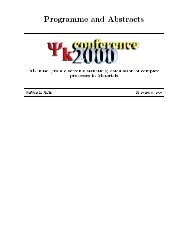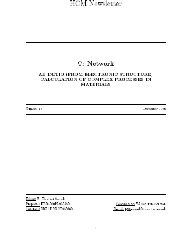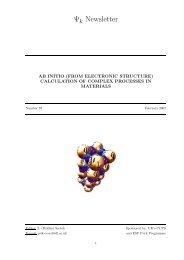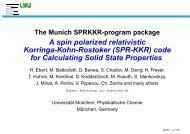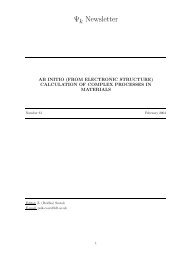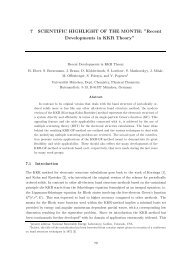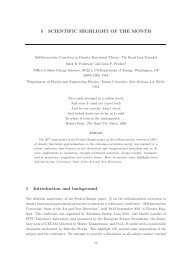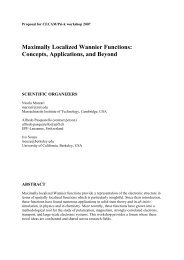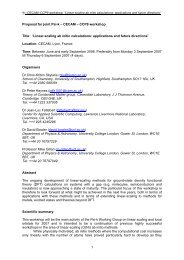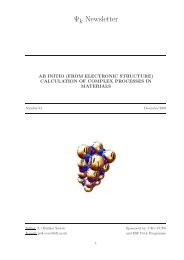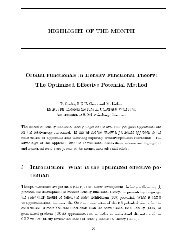Newsletter 107 - October 2011 - (pdf - 0.6 MB) - Psi-k
Newsletter 107 - October 2011 - (pdf - 0.6 MB) - Psi-k
Newsletter 107 - October 2011 - (pdf - 0.6 MB) - Psi-k
You also want an ePaper? Increase the reach of your titles
YUMPU automatically turns print PDFs into web optimized ePapers that Google loves.
Electronic Structure of Dye-Sensitized TiO 2 Clusters from<br />
Many-Body Perturbation Theory<br />
Noa Marom 1 , Jonathan E. Moussa 1 , Xinguo Ren 2 ,<br />
Alexandre Tkatchenko 2 , and James R. Chelikowsky 1<br />
1 Institute of Computational Engineering and Sciences,<br />
The University of Texas at Austin, Austin, Texas 78712, USA<br />
2 Fritz-Haber-Institut der Max-Planck-Gesellschaft,<br />
Faradayweg 4–6, 14195 Berlin, Germany<br />
Abstract<br />
The development of new types of solar cells is driven by the need for clean and sustainable<br />
energy. In this respect dye sensitized solar cells (DSC) are considered as a promising route<br />
for departing from the traditional solid state cells. The physical insight provided by computational<br />
modeling may help develop improved DSCs. To this end it is important to obtain<br />
an accurate description of the electronic structure, including the fundamental gaps and level<br />
alignment at the dye-TiO 2 interface. This requires a treatment beyond ground-state density<br />
functional theory (DFT). We present a many-body perturbation theory study, within<br />
the G 0 W 0 approximation, of two of the crystalline phases of dye-sensitized TiO 2 clusters,<br />
reported by Benedict and Coppens [J. Am. Chem. Soc. 132 (9), 2938 (2010)]. We obtain<br />
geometries in good agreement with experiment by using DFT with the Tkatchenko-Scheffler<br />
van der Waals correction. We demonstrate that even when DFT gives a good description<br />
of the valence spectrum and a qualitatively correct picture of the electronic structure of the<br />
dye-TiO 2 interface, G 0 W 0 calculations yield more valuable quantitative information regarding<br />
the fundamental gaps and level alignment. In addition, we systematically investigate the<br />
issues pertaining to G 0 W 0 calculations, namely: (i) convergence with respect to the number<br />
of basis functions, (ii) dependence on the mean field starting point, and (iii) the validity of the<br />
assumption that the DFT wave-function is a good approximation to the quasi-particle wavefunction.<br />
We show how these issues are manifested for dye molecules and for dye-sensitized<br />
TiO 2 clusters.<br />
(Phys. Rev. B, submitted (<strong>2011</strong>).)<br />
Contact person: Alexandre Tkatchenko (tkatchenko@fhi-berlin.mpg.de)<br />
35



